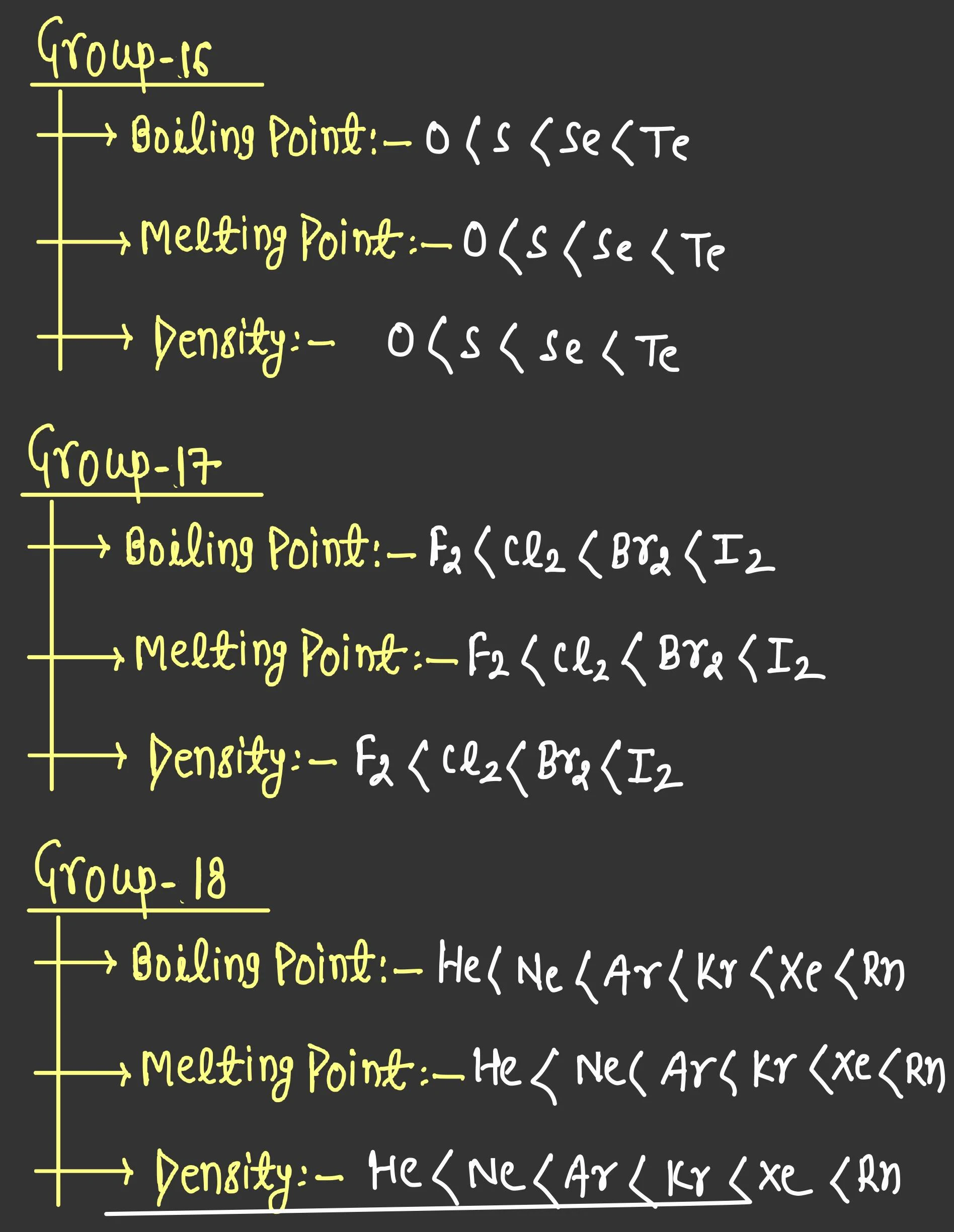Melting and Boiling Points - The boiling points and melting points of elements are key physical properties that depend on atomic structure, bonding, and intermolecular forces. Understanding these trends for s-block and p-block elements is essential for students in chemistry, especially when preparing for exams like JEE, NEET, and board exams.
This article provides detailed and structured notes on the boiling and melting points of s-block and p-block elements, with explanations of trends and their underlying factors.
Boiling Points and Melting Points: Key Concepts
1. Melting Point
Definition: The temperature at which a substance transitions from a solid to a liquid.Factors Affecting Melting Point:
- Type of bonding (ionic, covalent, metallic).
- Lattice structure and packing.
- Atomic or molecular size.
2. Boiling Point
Definition: The temperature at which a substance transitions from a liquid to a gas.Factors Affecting Boiling Point:
- Intermolecular forces (van der Waals forces, hydrogen bonding).
- Atomic or molecular weight.
- Nature of bonding.
Melting and Boiling Points of S-Block Elements
The s-block elements include Groups 1 (alkali metals) and Group 2 (alkaline earth metals). These elements exhibit distinct trends due to their metallic nature and simple atomic structures.
1. Group 1: Alkali Metals
Elements: Lithium (Li), Sodium (Na), Potassium (K), Rubidium (Rb), Cesium (Cs).Trend in Melting Points:
- Decreases down the group: Lithium has the highest melting point, while cesium has the lowest.
- Reason: Metallic bonds weaken as atomic size increases, reducing lattice strength.
- Decreases down the group, though less regular than melting points.
- Larger atoms result in weaker metallic bonding.
- Lithium: (melting), (boiling).
- Cesium: (melting), (boiling).
2. Group 2: Alkaline Earth Metals
Elements: Beryllium (Be), Magnesium (Mg), Calcium (Ca), Strontium (Sr), Barium (Ba).Trend in Melting Points:
- Decreases down the group: Stronger metallic bonding in smaller atoms like beryllium and magnesium.
- Generally decreases down the group due to weaker metallic bonds in larger atoms.
- Beryllium: (melting), (boiling).
- Barium: (melting), (boiling).
Key Points for S-Block Trends:
- Weak metallic bonding in larger atoms results in lower melting and boiling points.
- Alkali metals have lower melting and boiling points compared to alkaline earth metals due to their single valence electron.
Melting and Boiling Points of P-Block Elements
The p-block elements include Groups 13 to 18, covering a range of metals, metalloids, and nonmetals. The diversity of bonding and structure in the p-block results in complex trends.
1. Group 13: Boron Family
Elements: Boron (B), Aluminum (Al), Gallium (Ga), Indium (In), Thallium (Tl).Melting Points:
- Irregular trend: Boron has a very high melting point due to its covalent network structure.
- Gallium has an unusually low melting point (), allowing it to melt in hand.
- Generally decrease down the group due to metallic bonding weakening with increasing atomic size.
- Boron: (melting), (boiling).
- Gallium: (melting), (boiling).
2. Group 14: Carbon Family
Elements: Carbon (C), Silicon (Si), Germanium (Ge), Tin (Sn), Lead (Pb).
Melting Points:- Carbon (diamond): Extremely high melting point due to strong covalent bonds.
- Melting points decrease down the group due to weaker bonding in larger atoms.
- Decrease down the group; carbon and silicon exhibit high boiling points due to covalent network structures.
- Carbon: (melting), (boiling).
- Lead: (melting), (boiling).
3. Group 15: Nitrogen Family
Elements: Nitrogen (N), Phosphorus (P), Arsenic (As), Antimony (Sb), Bismuth (Bi).Melting Points:
- Increase down the group: Nitrogen is a gas with a very low melting point, while bismuth is a metal with strong metallic bonding.
- Increase down the group due to stronger intermolecular or metallic bonding.
- Nitrogen: (melting), (boiling).
- Bismuth: (melting), (boiling).
4. Group 16: Oxygen Family (Chalcogens)
Elements: Oxygen (O), Sulfur (S), Selenium (Se), Tellurium (Te), Polonium (Po).Melting Points:
- Increase down the group as elements transition from nonmetallic to metallic behavior.
- Increase down the group, reflecting stronger intermolecular forces or metallic bonding.
- Oxygen: (melting), (boiling).
- Polonium: (melting), (boiling).
5. Group 17: Halogens
Elements: Fluorine (F), Chlorine (Cl), Bromine (Br), Iodine (I), Astatine (At).Melting and Boiling Points:
- Increase down the group due to stronger van der Waals forces.
- Fluorine and chlorine are gases; bromine is a liquid; iodine and astatine are solids.
- Fluorine: (melting), (boiling).
- Iodine: (melting), (boiling).
6. Group 18: Noble Gases
Elements: Helium (He), Neon (Ne), Argon (Ar), Krypton (Kr), Xenon (Xe), Radon (Rn).Melting and Boiling Points:
- Very low due to weak dispersion forces.
- Increase down the group as atomic size and dispersion forces increase.
- Helium: (melting), (boiling).
- Xenon: (melting), (boiling).
Trends Summary
| Group | Trend in Melting Point | Trend in Boiling Point |
|---|---|---|
| S-Block | Decreases down the group | Decreases down the group |
| P-Block | Irregular but generally decreases down the group (varies by element) | Increases or varies based on bonding and molecular forces |
FAQs About Melting and Boiling Points
Why do alkali metals have low melting points?
Weak metallic bonding due to a single valence electron and large atomic size leads to low melting points.
Why does carbon have a high melting point?
Carbon (diamond) has a strong covalent network structure, requiring significant energy to break bonds.
Why does iodine have a higher boiling point than bromine?
Iodine’s larger size leads to stronger van der Waals forces compared to bromine.
The melting and boiling points of s-block and p-block elements are influenced by atomic size, bonding type, and intermolecular forces. By understanding these trends, students can master the concepts necessary for academic and competitive exams. Use these notes as a quick reference to build a solid foundation in physical properties of elements!






